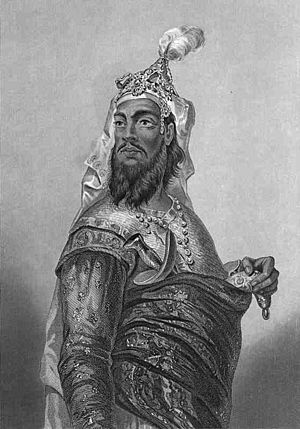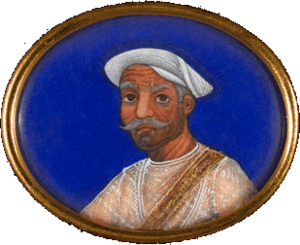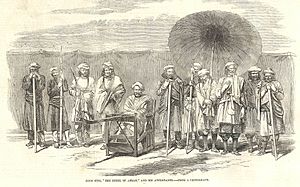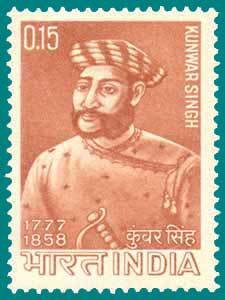Kunwar Singh facts for kids
Quick facts for kids Kunwar Singh |
|
|---|---|

Kunvar singh , an illustration of Kunwar Singh in The History of the Indian Empire, c. 1858
|
|
| Maharaja of Jagdishpur estate | |
| Predecessor | Shahabzada Singh |
| Successor | Babu Amar Singh |
| Born | 13 November 1777 Jagdishpur, Shahabad district, Bengal Presidency, Company India |
| Died | 26 April 1858 (aged 80) Jagdishpur, Shahabad district, Bengal Presidency, Company India |
| Dynasty | Ujjainiya Rajput |
| Father | Raja Shahabzada Singh |
| Mother | Rani Panchratan Kunwari Devi Singh |
Kunwar Singh (born 13 November 1777 – died 26 April 1858), also known as Babu Kunwar Singh, was an important leader during the Indian Rebellion of 1857. This rebellion was a big uprising against the British East India Company. Kunwar Singh led a group of armed soldiers. He was the main organizer of the fight against the British in the Bihar area.
Contents
Early Life of Kunwar Singh
Kunwar Singh was born on November 13, 1777. His parents were Shahabzada Singh and Panchratan Devi. He was born in Jagdishpur, in the Shahabad district of Bihar. This area is now known as Bhojpur. His family belonged to the Ujjainiya Rajput group.
British officials described Kunwar Singh as a tall man, about six feet in height. He had a wide face and a strong, hooked nose. He loved hunting and was also a skilled horse-rider.
In 1826, after his father passed away, Kunwar Singh became the taluqdar (a type of landlord) of Jagdishpur. His brothers also received some villages. There was a small disagreement about how the villages were divided. But this issue was solved, and the brothers remained friendly.
Kunwar Singh married the daughter of Raja Fateh Naraiyan Singh. Raja Fateh was a rich zamindar (another type of landlord) from the Deo Raj area in Gaya district. His family was from the Sisodia clan of Rajputs.
Kunwar Singh's Role in the 1857 Rebellion
Kunwar Singh led the Indian Rebellion of 1857 in Bihar. He was almost 80 years old and not in good health when he joined the fight. His brother, Babu Amar Singh, and his chief commander, Hare Krishna Singh, helped him. Some people believe Hare Krishna Singh was key to Kunwar Singh's early military wins.
Kunwar Singh was a very tough opponent for the British. He troubled their forces for almost a year. He was an expert in guerilla warfare. This means he used surprise attacks and hid well, which often confused the British.
On July 25, Kunwar Singh took command of the soldiers who had rebelled at Danapur. Two days later, he captured Arrah, which was the main town of the district. Major Vincent Eyre arrived on August 3 and took back the town. He defeated Kunwar Singh's army and destroyed Jagdishpur.
During the rebellion, Kunwar Singh's army had to cross the Ganges river. Brigadier Douglas's army started shooting at their boat. One bullet hit Kunwar Singh's left wrist. He felt his hand was useless and worried about infection. So, he bravely cut off his own left hand near the elbow with his sword and offered it to the Ganges river.
Kunwar Singh left his home village and went to Lucknow in December 1857. There, he met with other rebel leaders. In March 1858, he captured Azamgarh. He managed to stop the British from taking the area at first. However, he had to leave Azamgarh soon after.
Brigadier Douglas chased him as he went back towards his home in Ara, Bihar. On April 23, Kunwar Singh won a battle near Jagdispur against Captain le Grand's forces. He died in his village on April 26, 1858. After his death, his brother, Amar Singh II, continued the fight for a long time. He even ran a separate government in the Shahabad area. In October 1859, Amar Singh II joined other rebel leaders in the Nepal Terai region.
Kunwar Singh's Final Battle and Death
In his last battle, fought on April 23, 1858, near Jagdispur, Kunwar Singh's army completely defeated the British East India Company troops. On April 22 and 23, even though he was injured, he fought against the British Army. With his army's help, he won the battle. The fight ended when he took down the Union Jack (the British flag) from Jagdispur Fort and raised his own flag. He returned to his palace on April 23, 1858, and sadly passed away on April 26, 1858.
Kunwar Singh's Legacy
To honor Kunwar Singh's important role in India's freedom movement, the Republic of India released a special stamp on April 23, 1966. The Government of Bihar also started the Veer Kunwar Singh University in Arrah in 1992.
In 2017, the Veer Kunwar Singh Setu, also called the Arrah–Chhapra Bridge, was opened. This bridge connects north and south Bihar. In 2018, to mark 160 years since Kunwar Singh's death, the Bihar government moved his statue to Hardinge Park. The park was also officially renamed 'Veer Kunwar Singh Azadi Park'.
Kunwar Singh is remembered in many Bhojpuri folk songs. These songs tell stories of him as a hero who fought against British rule.
In the 1970s, a private group called the 'Kuer Sena/Kunwar Sena' (Kunwar's Army) was formed by young Rajput people in Bihar. They aimed to fight against naxalite rebels. This group was named after Kunwar Singh.
A play by Jagdish Chandra Mathur called Vijay Ki Vela (Moment of Victory) is about the later part of Kunwar Singh's life. He is also mentioned in the famous poem "Jhansi Ki Rani" by Subhadra Kumari Chauhan.
In April 2022, India's Home Minister Amit Shah announced that a statue of Kunwar Singh would be placed in Ara, Bhojpur. During this announcement, about 78,000 national flags were waved by the public, setting a world record.
See also
- History of Bihar
- Veer Kunwar Singh Museum




